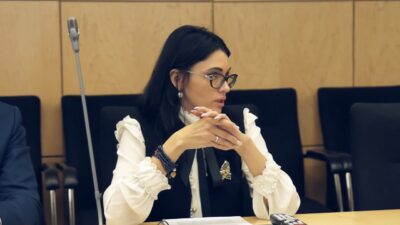Last Thursday, Ukraine took a long-planned plunge and disconnected from the Soviet-era power grid linking it to the Russian and Belarusian electricity systems — the same day that Russia launched its invasion.
Now Ukraine — along with Moldova, which also took part in the test — is hoping that what was supposed to be a three-day exercise of electricity independence will be made permanent and that the EU will allow them to join the synchronous grid of Continental Europe.
Ukrainian Energy Minister Herman Galushchenko extended the test to March 6; he’s lobbying the EU for permission to sync up with the European Network of Transmission System Operators (ENTSO-E) immediately — while counting the days Ukraine can keep the lights on with the energy supplies it has at hand.
“Despite military aggression by Russia, rocket attacks, attacks on critical infrastructure, the Ukrainian power system — working autonomously — has proven its reliability and security of electricity supply to consumers,” Galushchenko said Monday.
“We have proved the seriousness of our intentions to integrate with the European system, even in this difficult time of war,” he added. “I appeal to our European partners to synchronize Ukraine’s energy system with ENTSO-E as soon as possible. We need your support and solidarity with the Ukrainian people more than ever!”
On Monday, EU Energy Commissioner Kadri Simson met with ENTSO-E to discuss Ukraine’s early joining, a process called synchronization.
“Ukraine is asking for emergency synchronization with the European grid as soon as possible. This is technically challenging, but as Europe this is something tangible we can do for our partners,” Simson said Monday evening after an emergency meeting of the bloc’s energy ministers, adding that the process would take several weeks and would also link Moldova to the EU grid.
Synchronization was initially scheduled for early 2023, pending the outcome of this month’s winter test followed by a second summer test scheduled for August, both of which require Ukraine and Moldova to show they can stably operate their systems at 50 Hertz — the Continental standard — without the need for emergency power from a neighbor.
On Friday, an ENTSO-E spokesperson said Ukraine’s electricity transmission system operator Ukrenergo had passed the winter exam.
“Ukrenergo have reported the successful completion of the isolation tests [of] 24 February,” the spokesperson said via email. “In the meantime we are closely monitoring the situation in light of the current events that are constantly evolving.”
That situation is a Russian invasion.
Ukraine’s energy ministry is holding industry-wide briefing calls every two hours to keep abreast of the state of its power system. Internal electricity trading has been suspended in favor of a fixed price until further notice.
As of 2 p.m. Monday, Ukraine’s energy system was stable — though a reported 332,000 customers in the country were partially or completely cut off from electricity, and 11,675 consumers were cut off from gas supplies due to infrastructure damaged in the fighting, according to the ministry.
The country has 734,000 tons of coal stock on hand, enough to last 15 to 20 days. The government, however, has ordered all thermal power plants to switch to burning natural gas in case rail transport from coal mines in eastern Ukraine is blocked. As much as 40 percent of renewables are offline due to cut transmission lines.
On Monday, Ukraine’s nuclear plant operator Energoatom said its power stations were operating normally.
Along Ukraine’s western border, the Dobrotvorskaya power plant is directly connected to Poland’s electricity grid via transmission cables. It — together with Ukraine’s largest thermal power plant, Burshtyn — form a so-called energy island that in the past has been allowed to connect with the western grid for small-scale electricity trade.
Detaching from the Moscow-dominated IPS/UPS grid has become a political project.
“It means a lot because first of all it will be kind of the last milestone in terms of breaking up with our Soviet past,” Naftogaz CEO Yuriy Vitrenko told POLITICO on the eve of the invasion. When he was Ukraine’s energy minister, Vitrenko set synchronization as a strategic priority for the country.




